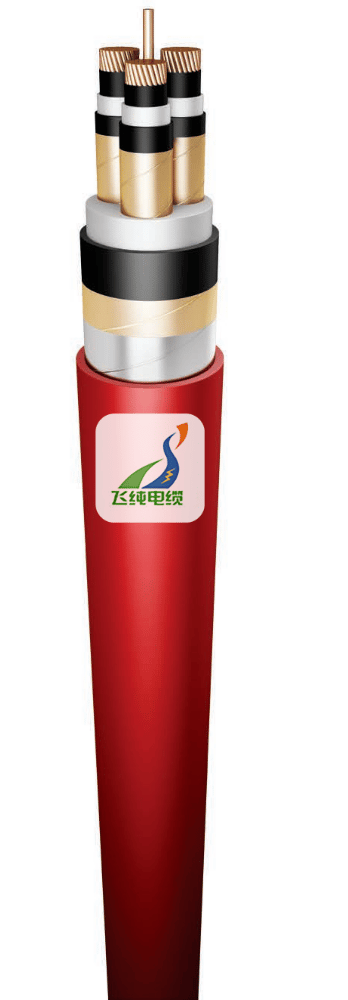Type YHKGXSekFtZnyn 3.6/6 kV mining cables
Power cable, mining, copper conductor, polyethylene insulation
Cross-linked, individual screen on each strand, PVC coated, with common screen,
Galvanized steel tape armor, PVC outer sheath, enhanced corrosion and oil resistance
For preventing the spread of flames


Type YHKGXSekFtZnyn 3.6/6 kV mining cables are designed for use in underground mining electrical networks, particularly in environments where safety against flame spread and robust performance is critical.
Below is a simplified breakdown of the cable's construction and features:
Construction and Materials:
Conductors: The cable features copper conductors with a round, multi-wire structure classified as class 2 according to EN 60228. These conductors are designed for flexibility and optimal electrical performance.
Insulation: The cable uses cross-linked polyethylene (XLPE) insulation (Type DIX 3), offering excellent electrical properties and thermal stability.
Individual Screens: Each conductor has its own screening made from conductive tape or polyethylene, which helps to protect the signal integrity and reduce electromagnetic interference.
Outer Sheath and Armor: The cable has an outer PVC sheath, providing resistance against flames and external mechanical stress. It also includes a galvanized steel tape armor, offering additional protection from physical damage, moisture, and corrosion.
Flame Retardant: The cable sheath is designed to prevent the spread of flames, meeting the IEC 60332-1-2 and IEC 60332-3-24C standards for fire resistance.
Performance and Specifications:
Operating Temperature: The cable can handle temperatures between -50°C (when laying without heating) and +90°C during normal operation. In the event of a short circuit, it can withstand up to +250°C.
Bending Radius: The minimum bending radius of the cable is 12 times its outer diameter.
Testing: The cable is tested at a voltage of 15 kV AC for 5 minutes at a frequency of 50Hz to ensure its integrity.
Current Rating: The current-carrying capacity varies depending on the cross-sectional area of the conductors. For example, a 25 mm² conductor can carry 146 A at an ambient temperature of 25°C.
Key Features:
Corrosion and Oil Resistance: The cable's PVC outer sheath offers enhanced protection against oil and corrosion, which is crucial for harsh mining environments.
Packaging: The cable is typically supplied in 500 or 1000 meter reels, with other lengths available upon request.
Applications: This cable is designed for installation in underground mining electrical networks with nominal voltages not exceeding 1 kV. It is suitable for use in both methane and non-methane environments in mines, rated for explosion risk categories A, B, and C for methane or coal dust.
Standards and Approvals:
The cable complies with the ZN-TF-203: 2014 standard and is approved by EMAG and WUG.
It meets RoHS (Restriction of Hazardous Substances) compliance, ensuring safe environmental handling.
Performance Adjustments:
Current Rating Adjustments: When cables are installed in parallel, the current-carrying capacity can be adjusted using a correction factor (Kg) depending on the number of cables installed above each other. The rating is reduced when multiple cables are laid on top of each other.
Temperature Compensation: If the ambient temperature exceeds 25°C, the current-carrying capacity of the cable can be adjusted using correction factors (Kt) based on the ambient temperature. For instance, at 30°C, the correction factor is 0.96.
Conclusion:
The YHKGXSekFtZnyn 3.6/6 kV mining cable is an essential choice for underground mining applications due to its strong flame retardant properties, corrosion resistance, and flexibility. With robust materials like copper conductors, XLPE insulation, and galvanized steel armor, it ensures reliable performance even in the most demanding environments.

Frequently Asked Questions (FAQ)
Q: What is the primary application of these cables?
A: They are designed for underground mining installations, particularly for power networks in mines with nominal voltages up to 1 kV.Q: What makes these cables suitable for harsh mining environments?
A: Their robust construction—including a copper conductor, XLPE insulation, dual shielding, galvanized steel tape armor, and a flame-resistant PVC outer sheath—ensures durability and safety in rugged conditions.Q: What conductor material is used in these cables?
A: The cables use stranded, round copper conductors, offering excellent electrical conductivity and flexibility.Q: How does the XLPE insulation benefit the cable performance?
A: XLPE provides high thermal resistance and excellent electrical insulation, which is critical for maintaining performance in high-temperature mining environments.Q: What is the purpose of having individual shielding on each conductor?
A: Individual shielding reduces electromagnetic interference and enhances the cable’s overall electrical performance, making it ideal for sensitive mining applications.Q: How is the overall shield constructed, and why is it important?
A: An overall copper tape shield is applied over the individually shielded conductors to further protect against electromagnetic interference and ensure stable operation.Q: Why is a galvanized steel tape armor used in these cables?
A: The galvanized steel tape armor offers robust mechanical protection against impacts, abrasion, and other physical damages common in mining operations.Q: What role does the PVC outer sheath play?
A: The PVC outer sheath not only protects the cable from environmental factors like oil and corrosion but is also formulated to resist the spread of flames, enhancing safety.Q: What are the operating temperature limits for these cables?
A: Under normal conditions, the cable can operate at conductor temperatures up to +90°C. For short-circuit events, temperatures may reach up to +250°C, while ambient installation temperatures can be as low as –30°C (fixed) or –50°C (without pre-heating).Q: How are these cables tested to ensure electrical integrity?
A: They undergo a high-voltage test using 15 kV AC for 5 minutes at 50 Hz, ensuring they meet rigorous electrical standards.Q: What standards and certifications do these cables comply with?
A: They meet Polish standard ZN-TF-203:2014, PN-HD 620 S1:2002 for insulation and sheath, IEC standards for flame resistance (IEC 60332-1-2, IEC 60332-3-24C), and environmental standards like RoHS63.Q: How does the cable’s design prevent the spread of flames?
A: The specially formulated PVC outer sheath has enhanced flame-retardant properties, ensuring that flames are contained and do not spread along the cable.Q: What is the minimum bending radius for these cables?
A: The minimum bending radius is 12 times the cable’s overall diameter, which helps prevent damage during installation.Q: Are these cables suitable for explosive atmospheres in mines?
A: Yes, they are designed for hazardous mining areas, including locations with methane or coal dust, making them safe for use in explosive atmospheres.Q: What range of conductor sizes is available for these cables?
A: Options range from 3x25 mm² up to 3x240 mm², allowing selection based on specific power and installation requirements.Q: How does stacking or grouping of cables affect their current-carrying capacity?
A: When cables are installed in groups or stacked, correction factors must be applied to reduce the current-carrying capacity as detailed in the technical documentation.Q: Can these cables be used for both fixed and mobile mining installations?
A: Yes, the cable’s design accommodates both fixed installations in underground mines and mobile applications in mining vehicles or temporary setups.Q: How does the cable handle mechanical stresses during installation?
A: The combination of a flexible copper conductor, reinforced shielding, and steel tape armor provides high tensile strength (rated at 50 times the conductor cross-sectional area), ensuring the cable withstands mechanical stresses.Q: What are the packaging options available for these cables?
A: Standard packaging includes 500 or 1000-meter drums, with customizable lengths and packaging options available to meet specific project needs.Q: How is the cable’s performance maintained in extreme temperature conditions?
A: The cable’s materials—such as XLPE insulation and the PVC outer sheath—are specifically chosen for their ability to operate reliably across a wide temperature range, ensuring consistent performance even in extreme conditions.Q: What measures are in place to ensure long-term durability in corrosive environments?
A: The PVC outer sheath is highly resistant to oil and corrosion, and the galvanized steel armor provides additional protection, making the cable well-suited for long-term use in harsh, corrosive mining environments.Q: How do the electrical properties, such as inductance and reactance, benefit mining operations?
A: Low inductance and reactance values help maintain efficient power transmission with minimal energy losses, which is essential for the stable operation of mining electrical systems.






Type YHKGXSekFtZnyn 3.6/6 kV Mining Cables
Type YHKGXSekFtZnyn 3.6/6 kV Mining Cable is engineered for underground mining power systems, especially in hazardous environments with potential methane or coal dust risks. It features stranded copper conductors with high conductivity and flexibility, insulated with high-temperature resistant XLPE. Each conductor is individually shielded and wrapped in an overall copper tape shield to minimize electromagnetic interference. A robust galvanized steel tape armor and a flame-retardant, oil- and corrosion-resistant PVC outer sheath provide exceptional mechanical and environmental protection. Certified to stringent standards, this cable is built to operate reliably across extreme temperatures, making it ideal for the demanding conditions of mining installations.
6/30/20216 min read
